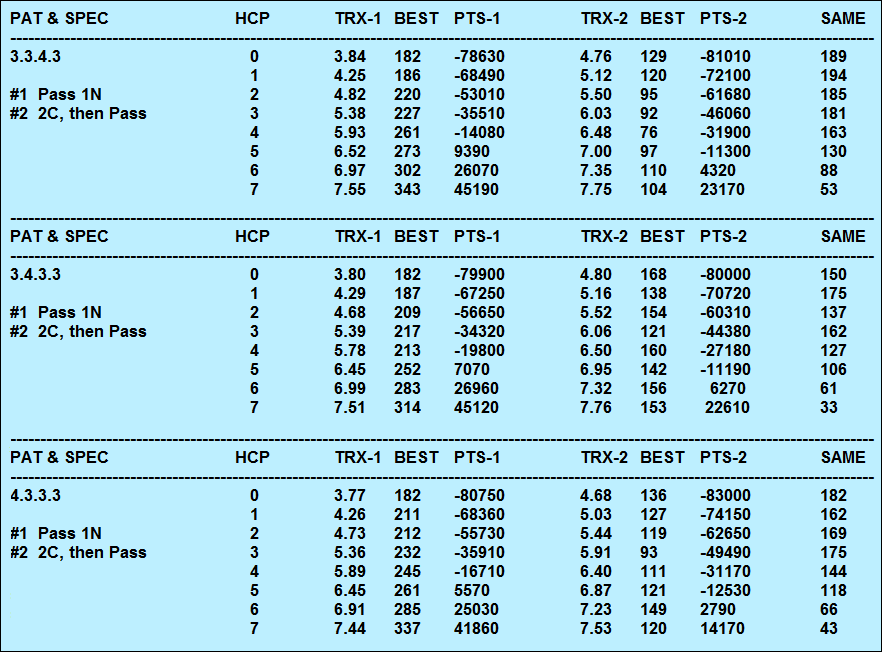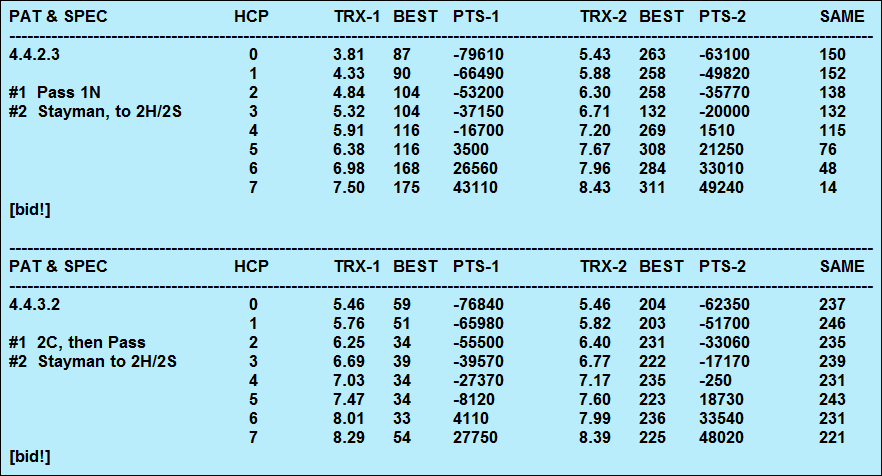

 |
 |
Responding to Notrump with Bad Hands
Your partner opens a 15-17 Notrump and you have a
4.4.4.1 hand with 2 hcp. This one is easy;
everyone knows to trot out Stayman, then pass any response. But what
if your pattern were 4.4.3.2, or 4.1.4.4, or
2.2.4.5. Would you bid? Possibly not, but you
should, and SIM will show you
why. There are other questions, such as how best to proceed when holding
a 4.5.1.3 pattern, or even an extreme case such as
5.1.0.7. SIM has the answers.
Firstly, however, a word about conventions is in order. In order to minimize losses with such weak hands, your system must incorporate these following methods to accommodate them effectively:
Of those conventions, a non-invitational form of Stayman is easily the most
important; in fact, many holdings cannot be handled effectively without it.
The ability to check for a major on the way to a minor-suit exit is a
highly useful device as well. Most modern players have abandoned that
old-fashioned approach; yet it is good enough for the likes of
Martel-Stansby, and it is good enough for me.
After reading this study, you might be skeptical of some of of SIM's suggestions on the basis that passing with flatter hands gives the opponents more room to get you off the hook by balancing. That observation has merit, of course. It would be invalid, however, to contend that you could earn your matchpoints by playing the hand better than your competitors, or that defenses tend to be imperfect, because those same factors would apply even after you had improved the contract according to SIM's directives.
In any case, it must be remembered that SIM does not
address the issues of competitive bidding and potential penalty doubles; it
knows only how many tricks can be taken on average, double-dummy, under
specified conditions. You must decide for yourself whether it is worth
amending your own system and philosophy to accommodate the computer's findings.
All studies are for 500 deals. I would like for that total to have been
higher; but well over 800 studies were run, totalling about 150 hours of computer
time and God only knows how much of my own. Each study compares two ways
of handling a certain pattern and strength. Results include the average number
of tricks won, the total non-vulnerable points accrued, and the number of
times each option scored better at matchpoints. Even though a holding of
6+ hcp is not actually a bad holding opposite a strong notrump, I included
hands up to 7-8 hcp because many of them do not qualify as a
game-try.
For the computer runs, opener's hands are restricted to the three most common
notrump patterns: 4-3-3-3, 4-4-3-2, and 5-3-3-2
with no long major. No consideration is given to honor placement or valuation
of specific card combinations. A jack is valued at 1 hcp, whether
it be a singleton or in a 6-card suit (Sorry, Edgar).
Although there is a lot of information here, it is unnecessary to assimilate it all as you read. If you find wading through the plethora of numbers tedious or my commentary to be boring, a summary chart is provided on the last page; also, an included .RTF file, readable with Wordpad or other word processor, contains the raw data from all the studies.
4-3-3-3
It is easist to begin with the flattest hands, and progress from there. Here is the first computer analysis:

As you can see, Option #1 (Pass) is best at every
level; and the better the hand, the more attractive a pass becomes.
Although trotting out Stayman is a long-term loser here, slightly more
tricks are won when the 4-card suit is diamonds, because sometimes there
is an 8+ fit there.
Of course, passing such hands has been your policy all along; so nothing much has been learned here. Next case.
4-4-3-2
With 4-4 in the minors, the only alternative to passing would be to go
for a 3-level fit in a minor. That also is not a useful approach,
but the situation differs as the major-suit lengths increase:

Playing in a suit is best at every point-level,
and it's not even close! The weaker the hand, the more important it is
to bid; this is a recurring phenomenon. Unfortunately, you will play an
occasional 4-2 diamond fit.
Because opener is constrained always to rebid hearts holding both majors,
a 4-4 spade fit sometimes is lost; therefore, when responder's longer
major is spades, bidding is not quite so productive. This also is a
common occurrence.

This time, the numbers say to pass with 7+ hcp,
and bid with less. With many patterns, the best option is dependent
upon the strength of responder's hand. Unfortunately, this fact necessitates
some heavy-duty memory work for maximum results in such cases; so the best
overall strategy might well be just to assimilate the general guidelines for all
this stuff, and be content with that. You'll still be far ahead of the
competition.
What about 4-4 majors? This is where Garbage Stayman shines; without it, one cannot handle this pattern effectively.

Observe that using Stayman is best at every level,
and that opting to play in diamonds with just 3-card support is particularly
bad. The major-suit trick score seems to compensate for a potentially
poorer fit.
Finally, a hand might have just one major, with no support for the other. In these results SIM provides us our first real surprise:

With a really bad hand the decision is close, yet on balance the winning move is
to transfer to the 4-card major! Note also
that more tricks are won at every level when there is a trump suit.
A drawback is that when this tactic goes sour, it can go up in flames.
4-4-4-1
It was suggested that everyone knows what to do with this pattern.
Is that really so? We already have determined that passing
1NT is not a good plan when three two-level options
are available, but perhaps playing in diamonds isn't best either.

It appears that the standard thinking should be adjusted somewhat.
When holding 6+ hcp, the additional strength makes a
possible 4-3 major fit more viable. irrespective of the
diamond fit; those 30-point overtricks add up.
Is there any merit to checking for a major, then retreating to notrump?
That might me workable, provided that 2NT was agreed as a
signoff — which is not the stuff of a typical partnership.
Let's find out:

Converting back to 2NT is reasonable only with the strongest
hands; otherwise, play in 2♦.
Perhaps that comes as no surprise, but it needed to be said. Opting for
a higher level of notrump never is a viable option with a bad hand.
Finally, the hands with a single major feature the next exciting surprise:

It seems that Transferring to the 4-card major is the standout action at every level, at any form of scoring! This is neat stuff; I can hardly wait to try it at the table, to the potential consternation of all.

Well, that's about it for the 4-card suits. What have we learned?
All results are itemized in the Summary. Meanwhile, let us move on to the
5-card patterns.